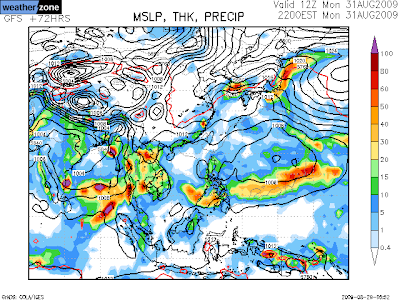Over 500 mm rainfall this season.
The revival of rainfall across the country over the past two weeks has helped a third of the country achieve the normal average level for the June-August period.
Of the 36 'monsoon divisions' into which the India Meteorological Department (IMD) has divided the country, 12 have achieved the normal average for this three-month period this year, thanks to the revival of the past fortnight.
| HOPE RETURNS Division-wise rainfall comparison | |||
| Period | June-Aug 27, 2008 | June-Aug 19, 2009 | June-Aug 26, 2009 |
| Excess | 6 divisions | 1 division | 1 division |
| Normal | 26 divisions | 9 divisions | 12 divisions |
| Deficient | 4 divisions | 25 divisions | 22 divisions |
| Scanty | 0 division | 1 division | 1 division |
| Note: Excess: ( +20% or more)Normal : (+19 % to -19%) Deficient: (-20% to -59%) Scanty: (-60% to -99%) Source: India Meteorological Department, Pune | |||
However, three parts in the country - Haryana, Himachal Pradesh and western Uttar Pradesh - have an average rainfall deficiency of more than 50 per cent as of now.
Tamil Nadu, Kerala, Karnataka, Orissa, Sikkim and Arunachal Pradesh, along with central Maharashtra, Rayalaseema (Andhra), Lakshadweep and Andaman and Nicobar Islands have crossed the normal average level. There are still 22 monsoon divisions, primarily in the states of Uttar Pradesh, Bihar, Jharkhand, Rajasthan, Andhra Pradesh and Maharashtra, which have reported deficient rainfall. The deficiency levels however have come down distinctly.
Haryana remains the only division with scanty rainfall (less 64 per cent) and Saurashtra-Kachchh in Gujarat the only region reporting excess rainfall (more by 29 per cent) till August 26, the IMD reports show. The entire country has got 514.3 mm of rainfall this season, almost 25 per cent less than the average normal of 682 mm till August 26.
A top IMD official told Business Standard there were chances of few more regions achieving the normal average rainfall level by the second week of September. "The situation in Haryana, Himachal Pradesh and western UP is really tough. These regions might not recover the shortfall of rains this season. Last year, over the same period, 26 divisions had received the normal average rainfall. The only positive aspect is that deficiency levels have sharply reduced across a number of monsoon divisions," the official stated.

